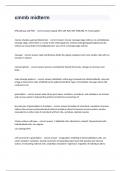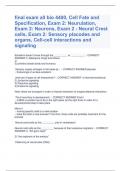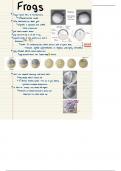Epiboly Study guides, Class notes & Summaries
Looking for the best study guides, study notes and summaries about Epiboly? On this page you'll find 12 study documents about Epiboly.
All 12 results
Sort by

-
BIO 4400 FINAL EXAM, CELL FATE AND SPECIFICATION, EXAM 2: NEURULATION, EXAM 2: NEURONS, EXAM 2 - NEURAL CREST CELLS, EXAM 2: SENSORY PLACODES AND ORGANS, CELL-CELL INTERACTIONS AND SIGNALING & ANSWERS (VERIFIED ANSWERS) | GRADED+ | LATEST DONE
- Exam (elaborations) • 159 pages • 2024
-
- $12.89
- + learn more
Ectoderm doesn't move through the __________ or __________ ANSWER: 1) blastopore (frogs and fishes) or 2) primitive streak (birds and humans) Sensory organs all begin in the head as... ANSWER: placode - thickenings of surface ectoderm what are 4 types of cell interactions? ANSWER: 1) Internal/mechanical 2) Juxtacrine signaling 3) Paracrine signaling 4) Endocrine signaling Note: these are arranged in order of closest interaction to longest distance interaction The 6 word key to ...

-
final exam all bio 4400, Cell Fate and Specification, Exam 2: Neurulation, Exam 2: Neurons, Exam 2 - Neural Crest cells, Exam 2: Sensory placodes and organs, Cell-cell interactions and signaling
- Exam (elaborations) • 95 pages • 2024
-
- $30.49
- + learn more
final exam all bio 4400, Cell Fate and Specification, Exam 2: Neurulation, Exam 2: Neurons, Exam 2 - Neural Crest cells, Exam 2: Sensory placodes and organs, Cell-cell interactions and signaling Ectoderm doesn't move through the __________ or __________ - CORRECT ANSWER 1) blastopore (frogs and fishes) or 2) primitive streak (birds and humans) Sensory organs all begin in the head as... - CORRECT ANSWER placode - thickenings of surface ectoderm what are 4 types of cell interact...

-
final exam all bio 4400, Cell Fate and Specification, Exam 2: Neurulation, Exam 2: Neurons, Exam 2 - Neural Crest cells, Exam 2: Sensory placodes and organs, Cell-cell interactions and signaling
- Exam (elaborations) • 95 pages • 2024
-
- $20.49
- + learn more
final exam all bio 4400, Cell Fate and Specification, Exam 2: Neurulation, Exam 2: Neurons, Exam 2 - Neural Crest cells, Exam 2: Sensory placodes and organs, Cell-cell interactions and signaling Ectoderm doesn't move through the __________ or __________ - CORRECT ANSWER 1) blastopore (frogs and fishes) or 2) primitive streak (birds and humans) Sensory organs all begin in the head as... - CORRECT ANSWER placode - thickenings of surface ectoderm what are 4 types of cell interact...

-
final exam all bio 4400, Cell Fate and Specification, Exam 2: Neurulation, Exam 2: Neurons, Exam 2 - Neural Crest cells, Exam 2: Sensory placodes and organs, Cell-cell interactions and signaling
- Exam (elaborations) • 95 pages • 2024
-
- $30.49
- + learn more
final exam all bio 4400, Cell Fate and Specification, Exam 2: Neurulation, Exam 2: Neurons, Exam 2 - Neural Crest cells, Exam 2: Sensory placodes and organs, Cell-cell interactions and signaling Ectoderm doesn't move through the __________ or __________ - CORRECT ANSWER 1) blastopore (frogs and fishes) or 2) primitive streak (birds and humans) Sensory organs all begin in the head as... - CORRECT ANSWER placode - thickenings of surface ectoderm what are 4 types of cell interact...

-
cmmb midterm(question n answers)graded A+ 2024/2025
- Exam (elaborations) • 17 pages • 2024
- Available in package deal
-
- $17.99
- + learn more
cmmb midtermRTK pathway and FGFs - correct answer Ligand, RTK, GEF, RAS, RAF, MEK,ERK, TF, Transcription morula, blastula, gastrula blastomere - correct answer morula: cleavage stage embryo, no cavityblastula: cleavage stage, when there is a cavity in the embryogastrula: embryo undergoing gastrulationneurula: embryo as neural tube is formingblastomere: any cell of a cleavage stage embryo cleavage - correct answer rapid cell divisions divide the zygote cytoplasm into many smaller cells w...

-
LATEST bio 4400, Cell Fate and Specification, Exam 2: Neurulation, Exam 2: Neurons, Exam 2 - Neural Crest cells, Exam 2: Sensory placodes and organs, Cell-cell interactions and signaling EXAM WITH ANSWERS
- Exam (elaborations) • 95 pages • 2024
-
- $14.49
- + learn more
Ectoderm doesn't move through the __________ or __________ - CORRECT ANSWER 1) blastopore (frogs and fishes) or 2) primitive streak (birds and humans) Sensory organs all begin in the head as... - CORRECT ANSWER placode - thickenings of surface ectoderm what are 4 types of cell interactions? - CORRECT ANSWER 1) Internal/mechanical 2) Juxtacrine signaling 3) Paracrine signaling 4) Endocrine signaling Note: these are arranged in order of closest interaction to longest distance interactio...

-
final exam all bio 4400, Cell Fate and Specification, Exam 2: Neurulation, Exam 2: Neurons, Exam 2 - Neural Crest cells, Exam 2: Sensory placodes and organs, Cell-cell interactions and signaling
- Exam (elaborations) • 95 pages • 2024
-
- $13.49
- + learn more
final exam all bio 4400, Cell Fate and Specification, Exam 2: Neurulation, Exam 2: Neurons, Exam 2 - Neural Crest cells, Exam 2: Sensory placodes and organs, Cell-cell interactions and signaling Ectoderm doesn't move through the __________ or __________ - CORRECT ANSWER 1) blastopore (frogs and fishes) or 2) primitive streak (birds and humans) Sensory organs all begin in the head as... - CORRECT ANSWER placode - thickenings of surface ectoderm what are 4 types of cell interact...

-
final exam all bio 4400, Cell Fate and Specification, Exam 2: Neurulation, Exam 2: Neurons, Exam 2 - Neural Crest cells, Exam 2: Sensory placodes and organs, Cell-cell interactions and signaling
- Exam (elaborations) • 95 pages • 2024
-
- $14.99
- + learn more
final exam all bio 4400, Cell Fate and Specification, Exam 2: Neurulation, Exam 2: Neurons, Exam 2 - Neural Crest cells, Exam 2: Sensory placodes and organs, Cell-cell interactions and signaling Ectoderm doesn't move through the __________ or __________ - CORRECT ANSWER 1) blastopore (frogs and fishes) or 2) primitive streak (birds and humans) Sensory organs all begin in the head as... - CORRECT ANSWER placode - thickenings of surface ectoderm what are 4 types of cell interact...

-
Frog/Amphibian Embryonic Development
- Class notes • 4 pages • 2023
-
- $7.49
- + learn more
Describes the physical and genetic components of frog fertilization and embryonic stages. Describes rotation and polarity of frog embryo and the polarity of the blastula. Also describes epiboly and intercalation of embryonic germ layers.

-
final exam all bio 4400, Cell Fate and Specification, Exam 2: Neurulation, Exam 2: Neurons, Exam 2 - Neural Crest cells, Exam 2: Sensory placodes and organs, Cell-cell interactions and signaling
- Exam (elaborations) • 95 pages • 2024
-
- $14.99
- + learn more
Ectoderm doesn't move through the __________ or __________ - CORRECT ANSWER 1) blastopore (frogs and fishes) or 2) primitive streak (birds and humans) Sensory organs all begin in the head as... - CORRECT ANSWER placode - thickenings of surface ectoderm what are 4 types of cell interactions? - CORRECT ANSWER 1) Internal/mechanical 2) Juxtacrine signaling 3) Paracrine signaling 4) Endocrine signaling Note: these are arranged in order of closest interaction to longest distance interact...



